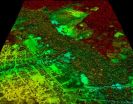(Press-News.org) Palo Alto, CA—By integrating satellite mapping, airborne-laser technology, and ground-based plot surveys, scientists from the Carnegie Institution's Department of Global Ecology, with colleagues from the World Wildlife Fund and in coordination with the Peruvian Ministry of the Environment (MINAM), have revealed the first high-resolution maps of carbon locked up in tropical forest vegetation and emitted by land-use practices. These new maps pave the way for accurate monitoring of carbon storage and emissions for the proposed United Nations initiative on Reduced Emissions from Deforestation and Degradation (REDD). The study is published in the September 6, 2010, early edition of the Proceedings of the National Academy of Sciences.
The United Nations REDD initiative could create financial incentives to reduce carbon emissions from deforestation and degradation. However, this and similar carbon monitoring programs have been hindered by a lack of accurate, high-resolution methods to account for changes in the carbon stored in vegetation and lost through deforestation, selective logging, and other land-use disturbances. The new high-resolution mapping method will have a major impact on the implementation of REDD in tropical regions around the world.
The study covered over 16,600 square miles of the Peruvian Amazon—an area about the size of Switzerland. The researchers used a four-step process: They mapped vegetation types and disturbance by satellite; developed maps of 3-D vegetation structure using a LiDAR system (light detection and ranging) from the fixed-wing Carnegie Airborne Observatory; converted the structural data into carbon density using a small network of field plots on the ground; and integrated the satellite and LiDAR data for high-resolution maps of stored and emitted carbon. The scientists combined historical deforestation and degradation data with 2009 carbon stock information to calculate emissions from 1999-2009 for the Madre de Dios region.
"We found that the total regional forest carbon storage was about 395 million metric tons and emissions reached about 630,000 metric tons per year," explained lead author Greg Asner. "But what really surprised us was how carbon storage differed among forest types and the underlying geology, all in very close proximity to one another. For instance, where the local geology is up to 60 million years old, the vegetation retains about 25% less carbon than the vegetation found on geologically younger, more fertile surfaces. We also found an important interaction between geology, land use, and emissions. These are the first such patterns to emerge from the Amazon forest."
The scientists also found that the paving of the Interoceanic Highway, combined with selective logging and gold mining, caused an increase of deforestation emissions of more than 61% by 2009, while degradation emissions doubled. Forest degradation increased regional carbon emissions by 47% over deforestation alone. However, the researchers were able to detect an 18% offset to these regional emissions in forests regrowing on previously cleared and now abandoned lands.
Members of the Peruvian government participated throughout the research process to familiarize themselves with the new method. In doing so, they aimed to assess the method's advantages, evaluate deforestation and forest disturbance, and determine carbon stocks in an environmentally critical area of Madre de Dios, Peru. "A valuable opportunity has opened for MINAM to count on Carnegie's scientific and technical support. This will strengthen our ability to monitor the Amazon forest, build experience in improving the interpretation of the country's environmental and land management conditions, and contribute to the establishment of the REDD mechanism," says Doris Rueda, director of Land Management at MINAM.
To support REDD, the Intergovernmental Panel on Climate Change (IPCC) issued baseline carbon density estimates for different biomes of the world, while also encouraging higher resolution approaches. When used for the Peruvian study area, the IPCC baseline estimate for carbon storage is 587 million metric tons. Based on the new Carnegie approach, the estimated total is 395 million metric tons. Under REDD-type programs, however, the high-resolution accuracy of the new approach would yield more credit per ton of carbon, thereby providing financial incentives for slowing deforestation and degradation.
Carnegie scientists are expanding their demonstration and training efforts in the high-resolution mapping technique with the governments of Ecuador and Colombia.
INFORMATION:
The research was supported by the Government of Norway, the Gordon and Betty Moore Foundation, the W. M. Keck Foundation, and William R. Hearst III.
Imag http://carnegiescience.edu/prasnercarbonstoragereddpicamazonlidar83010
Caption-- A new high-resolution airborne and satellite mapping approach provides detailed information on carbon stocks in Amazonia. This image shows an area of road building and development adjacent to primary forest in red tones, and secondary forest regrowth in green tones. Image from the Carnegie Airborne Observatory, Carnegie Institution for Science
The Carnegie Institution for Science (CarnegieScience.edu) has been a pioneering force in basic scientific research since 1902. It is a private, nonprofit organization with six research departments throughout the U.S. Carnegie scientists are leaders in plant biology, developmental biology, astronomy, materials science, global ecology, and Earth and planetary science.
A new study in the September 6 issue of the Journal of Cell Biology (www.jcb.org) helps define the role of an important ciliary protein, CEP290. The results could be applied toward targeted gene therapy in cilia-related diseases.
Mutations in human CEP290 cause cilia-related disorders that range in severity from isolated blindness to perinatal death. CEP290 mutations are known to cause Meckel syndrome, Joubert syndrome, and NPHP—the most common syndromic form of cystic kidney disease in childhood—among others.
Although the exact role of CEP290 has been unclear, a ...
Like some people, cells eat when they are under pressure—but they consume parts of themselves. A multi-function protein helps control this form of cannibalism, according to a study in the September 6 issue of the Journal of Cell Biology (www.jcb.org).
Cells often respond to hunger or stress by digesting some of their contents. The process, known as autophagy, helps free nutrients and clean up cytoplasmic trash such as worn-out organelles and misshapen proteins. A team led by researchers at the University of Pittsburgh Cancer Institute discovered a link between this form ...
Cancer is a difficult disease to treat because it's a personal disease. Each case is unique and based on a combination of environmental and genetic factors. Conventional chemotherapy employs treatment with one or more drugs, assuming that these medicines are able to both "diagnose" and "treat" the affected cells. Many of the side effects experienced by chemotherapy patients are due to the fact that the drugs they are taking aren't selective enough. For instance, taking a drug that targets fast-growing tumor cells frequently results in hair loss, because cells in the ...
The recession is finally taking its toll on national, state and local unionization rates, according to UCLA's annual report on organized labor.
Following an uptick last year, unionization rates fell between July 1, 2009, and June 30, 2010, by just more than half a percentage point in California and by a full percentage point in the five-county Los Angeles metropolitan area, researchers at UCLA's Institute for Research on Labor and Employment (IRLE) found.
"Given the duration and depth of the recession, it was inevitable that union jobs would be hit," said Lauren ...
Plaque-causing bacteria can jailbreak from the mouth into the bloodstream and increase your risk of heart attack says a scientist at the Society for General Microbiology's autumn meeting in Nottingham.
Professor Howard Jenkinson, from the University of Bristol explains how oral bacteria can wreak havoc if they are not kept in check by regular brushing and flossing. "Poor dental hygiene can lead to bleeding gums, providing bacteria with an escape route into the bloodstream, where they can initiate blood clots leading to heart disease," he said.
Streptococcus bacteria ...
Selfish bacterial cells that act in their own interests and do not cooperate with their infection-causing colleagues can actually reduce the severity of infection.
The selfish behaviour of these uncooperative bacteria could be exploited to treat antibiotic-resistant infections, according to research being presented at the Society for General Microbiology's autumn meeting today.
Bacteria work together by using a well-studied communication system called Quorum Sensing (QS). During infection, bacteria talk to each other using QS to coordinate the release of toxins.
Researchers ...
While we are often exposed to bacteria in our food which could cause food poisoning, we don't always become ill - why should this be so?
Professor Colin Hill who is presenting his work at the Society for General Microbiology's autumn meeting in Nottingham today describes how bacteria use different tricks to aid their survival inside the body, helping to explain why food poisoning can be so unpredictable.
One of the biggest challenges faced by food-borne bacteria is acid. Acidic conditions, particularly in the stomach and in the gut will kill most microbes found in contaminated ...
TORONTO, ON - Widespread reports of a decline in the population of bees and other flower-visiting animals have aroused fear and speculation that pollination is also likely on the decline. A recent University of Toronto study provides the first long-term evidence of a downward trend in pollination, while also pointing to climate change as a possible contributor.
"Bee numbers may have declined at our research site, but we suspect that a climate-driven mismatch between the times when flowers open and when bees emerge from hibernation is a more important factor," says James ...
STOCKHOLM (6 September 2010)—Against a backdrop of extreme weather wreaking havoc around the world, a new report warns that increasingly erratic rainfall related to climate change will pose a major threat to food security and economic growth, especially in Africa and Asia, requiring increased investment in diverse forms of water storage as an effective remedy.
"Millions of farmers in communities dependent on rainfed agriculture are at risk from decreasing and erratic availability of water," said Colin Chartres, director general of the Sri Lanka-based International Water ...
CAMBRIDGE, Mass. -- Plants are good at doing what scientists and engineers have been struggling to do for decades: converting sunlight into stored energy, and doing so reliably day after day, year after year. Now some MIT scientists have succeeded in mimicking a key aspect of that process.
One of the problems with harvesting sunlight is that the sun's rays can be highly destructive to many materials. Sunlight leads to a gradual degradation of many systems developed to harness it. But plants have adopted an interesting strategy to address this issue: They constantly break ...




